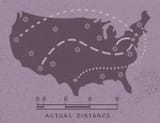
Channeling Your Back-end Developer
You’ve heard the assertion before: Designers should learn how to code. Reading through the many articles and comments on the topic, this discussion has focused predominantly on front-end development. Yes, comps fail to capture behavior and the in-betweens that bring your responsive designs to life, but crucially, front-end code isn’t the only step to actualizing your designs. Even if your coded styles remain faithful to your design intent, it’s your content that will put that design to test. If you care about the way content should look in your designs, you should also care about the logic that powers it.








